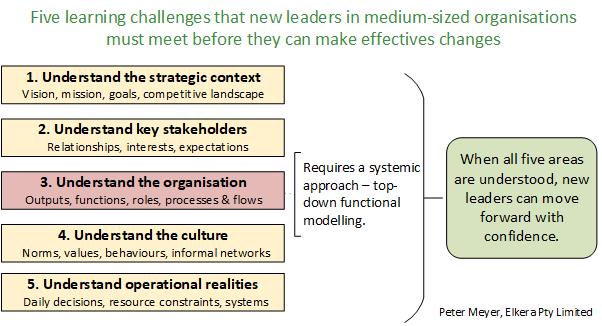Leadership challenge: How new leaders can understand the business and deliver results fast
By Peter Meyer, Principal Consultant, Elkera Pty Limited
11 August 2025
Over the past few years, I have observed a medium-sized organisation cycle through three different CEOs. The organisation is financially constrained and must adjust its business model and grow its market if it is to survive.
Yet none of these CEOs made any meaningful change to the organisational structure or its operating model. Each failed to grasp how the business operated or to define and address its strategic challenges. At best, they administered the business, but they did not lead it. As a result, the organisation continues to drift, no closer to resolving the issues that threaten its viability.
This case is far from unique. Research suggests that around 40% of executives in new roles fail within 18 months [Korn Ferry, 2012]. In this case, the CEOs stayed longer than that, but none left behind a stronger, more sustainable business. Nor were their own reputations visibly enhanced.
The consequences of such leadership failure are serious for both the leader and the organisation.
Many factors affect leadership success, including capability, experience, personality, and biases in the recruitment process, as I discussed in Selection biases in leadership recruitment and how to avoid them [Meyer, May 2025].
In this article I focus on a more fundamental issue: many new leaders never develop a deep understanding of how the organisation works or, if they do, it takes too long for them to figure it out.
New leaders may look at organisation charts, PDs, talk to people and attend meetings. But these informal approaches rarely give a complete or accurate picture. Without structure, the learning process is slow and error-prone, something neither the leader nor the organisation can afford.
In this article, I propose a structured approach to help new leaders quickly build a deep understanding of how the business operates. It systematically examines the business’s outputs, how they are produced, by whom and through which processes. That operational clarity directly supports the strategic analysis a new leader must undertake and provides a foundation for aligning the organisation to its future goals.
The objective is to help new leaders lead sooner, more effectively, and with greater confidence.
1. The expectations and pressures on new leaders
Few leaders are brought in merely to maintain the status quo. Most are expected to reposition or reinvigorate the business in response to strategic, structural or market challenges.
Multiple stakeholders may have high expectations of the new leader. Many within the organisation will be hoping for change, particularly improvements in how the business is organised and managed.
If the leader does not act quickly to develop and communicate a plan, cynicism can set in. The longer it takes to understand the business and articulate a vision, the harder it becomes to take decisive action. Early impressions are important. The first months set the tone for everything that follows.
How then are new leaders to meet those expectations?
New leaders have to deal with the day to day demands of running the business. At the same time, they have to manage multiple learning challenges before they can move forward. They must simultaneously establish relationships with key stakeholders, understand the business’s strategic environment, its organisational structure, its operations and its culture.
If the new leader is to avoid cynicism and loss of momentum, those learning challenges must be addressed simultaneously.
Leaders must understand the business as an organisation before they can lead it through the required changes.
A new leader needs a fast and efficient way to understand the organisation while simultaneously working on the other learning challenges.
2. Why informal learning isn’t enough
Many medium-sized businesses lack meaningful documentation to describe how the organisation works.
The documentation that is available may not be very helpful. For instance:
- Org charts are often outdated or misleading. They reflect formal reporting lines but not business functions and process flows. In siloed organisations, org charts can actively obscure how work moves between teams.
- Position descriptions are often no better. Commonly drafted by HR with limited operational input, they may focus on behavioural traits or cultural values rather than actual work responsibilities.
With little reliable documentation, new leaders must rely on informal learning, mostly by talking to people. But that has its own challenges. Existing managers are often keen to impress and position themselves as indispensable. Few will highlight systemic problems that implicate their own areas. Even well-intentioned managers may present a narrow view shaped by their personal interests.
While some will speak candidly, the overall picture is likely to remain fragmented. To gain real insights, a new leader must actively seek out diverse perspectives and ask probing questions.
Relying solely on informal learning is slow and unreliable. Without a structured understanding, new leaders risk making early decisions based on incomplete or misleading information.
3. A better way: functional modelling
The most efficient way to understand how the business works is to apply a systemic approach and use the business analysis techniques of functional modelling.
I have described functional modelling in my article: Growing pains for medium businesses: Why you should clearly define internal business structure [Meyer, June 2025].
Functional modelling is a top-down process that maps what the business produces and how. At the top level, it identifies:
- Primary business functions (also called core functions or value chain activities), being those that directly produce and deliver business outputs to customers.
- Support or secondary functions such as infrastructure management, HR management, technology management, marketing and legal.
- The role primarily responsible for each function.
- Key collaborators who support or contribute to the function.
Once the primary functions are identified, it is possible to define the processes that are involved in the performance of those functions. High level processes can be decomposed into more detailed processes where that extra detail is considered relevant. That is called a functional decomposition.
4. Applying functional modelling early
A new leader will not personally undertake the functional modelling. The work is best undertaken by an experienced business analysis consultant.
The work can proceed while the leader is addressing the other learning challenges. The leader can be involved as desired, by attending workshops and reviewing deliverables.
The overall process involves:
- Develop a functional map of the business as it is (current state).
- Review the current state functions and processes to identify areas for improvement.
- Develop a future state functional map of the business to guide change planning.
To develop the current state model, the business analysis consultant must work with business leaders to:
- Identify senior personnel with detailed knowledge of processes who will be consulted during the analysis
- Conduct interviews and workshops with process experts
- Develop draft function maps
- Validate draft function maps with stakeholders.
Top-down functional modelling allows leaders to see the landscape of the organisation and determine where further analytical work is useful and where it is unnecessary. In that way, leaders can ensure that work undertaken is focused and aligned to securing real business benefits.
5. Benefits of functional modelling
A functional model reveals how work actually gets done. In particular, it will:
- Provide a taxonomy of business functions and processes that will enable managers to define operational roles and understand what functions must be managed by those roles.
- Enable leaders to analyse the staffing requirements for specific functions.
- Support the re-organisation of functions and business units to remove siloes and improve workflows.
- Provide a foundation for the more detailed business process analysis that is required for process improvement and systems planning.
- Support role clarity, making it easier to define performance expectations, conduct performance reviews, and recruit effectively.
- Improve onboarding and staff handover.
- Support the development of simple role guides or process summaries to minimise reliance on the knowledge of particular individuals for critical functions.
The functional model will provide leaders with a thorough, objective understanding of the business to support effective decision making.
6. Conclusion
New leaders do not have the luxury of time to deal sequentially with the multiple learning challenges that must be met to effectively understand the business and to setup the change process that is needed in most cases. New leaders should address all five learning challenges simultaneously.
Nor can leaders afford to rely on informal, piecemeal methods to understand how the business operates. If, as is the case for many medium-sized business, there is no meaningful documentation to describe how the organisation works, a new leader should undertake a systemic approach to developing that documentation.
Leaders can set up a project to develop a functional model for the organisation with the guidance of an experienced business analysis consultant. The functional model is a flexible, light weight approach that will provide the leader with the information required to understand how the business works and to assess how it’s structure and systems can be improved to best meet its strategic objectives.
By adopting a structured, systemic approach, new leaders can address these challenges with greater clarity and confidence, and put the business on a path to sustainable success.
If these challenges are familiar, I invite you to contact me to discuss how we can use functional modelling to accelerate your leadership impact.
References
[Korn Ferry, 2012] Korn/Ferry International, (2012), Talent management best practice series, Executive onboarding.
[Meyer, May 2025] Meyer P (May 2025) Selection biases affecting leadership recruitment in organisations and how to avoid them.
[Meyer June 2025] Meyer P (June 2025) Growing pains for medium businesses: Why you should clearly define internal business structure.



